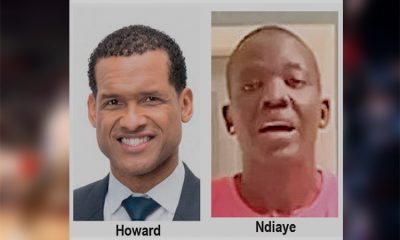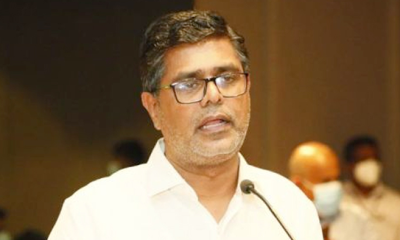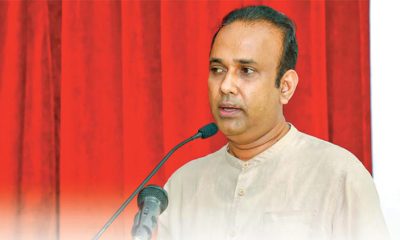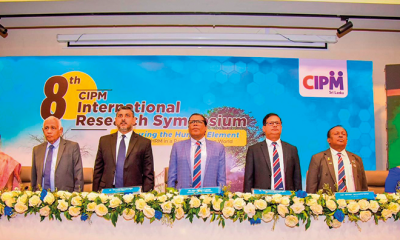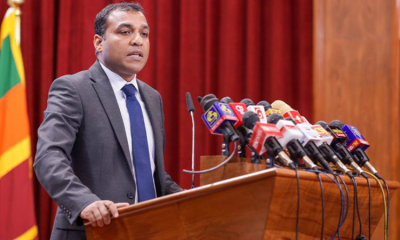Features
When Deadman could not prevent disaster
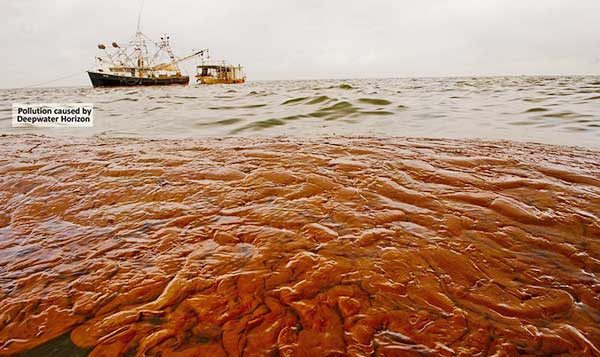
Biggest marine oil spill in history
By Captain Chandra
Godakanda Arachchi
Member of Company of Master Mariners
Gladstone LNG (Oil and gas producer and exporter)
Deepwater Horizon (DH) was a semi-submersible drill rig, which operated in a depth of approximately 1600 metres in the Gulf of Maxico. On charter to British Petroleum (BP), it was drilling possibly to a depth of 2,600 metres below the seabed about 50 miles off the Louisiana coast, within the exclusive economic zone of the US when an explosion occurred on 10 April 2010, killing 11 and injuring 17; 94 workers on board were rescued.
Crude oil and natural gas from the DH well continued to flow post explosion for 87 days until BP finally managed to cap it on 15 July 2010 and shut the flow. Consequently, the incident caused an unprecedented spill (780,000 cubic meters of crude oil as per the government data) although BP mentioned a lower amount. Worse, an unestimable amount of gas escaped into the atmosphere. The accident took a heavy toll on marine life, shore birds, shorelines, beaches, etc., even beyond the Gulf of Mexico. Dolphins, tuna, turtles, etc., died in large numbers. BP took up the challenge of cleaning up the mess, spending huge amount of dollars. Extensive cleaning continued for four long years. BP established a fund, the Gulf Coast Claims Facility with US$ 20 billion, to settle the claims.
The amount of crude oil that escaped from DH well is about 19 times what gushed out of the tanker, Exxon Valdez, which grounded in Alaska in 1989. This amount would have been sufficient for the Sapugaskanda Refinery for more than 100 days.
What went wrong on the fateful day? Here is what is thought to have happened!
Drilling an oil well is a highly skilled and specialised work. Once the site is determined for drilling post seismic surveys of the area, then a drilling rig is assembled at the correct location with all required material including safety gear. Drilling rigs use pipes which are about 20 metres in length, join these together as the drill head finds its way down. Drilling involves creating a flow path (deep hole or a well bore) under reservoir pressure thousands of meters below earth surface. The drill head can pass through various layers of earth crust, which can contain oil, gas and water under pressure, and this can lead to a dangerous unplanned release of oil and gas (or ‘kicks’). If a “kick” is not arrested in time, it can lead to a blowout of oil and gas from the well. In order to control such ‘kicks’, there is a specific piece of safety equipment known as “blowout preventer (BOP), installed close to the seabed, fitted on a larger pipe connected to the rig. Essentially, the drill pipe which is smaller is located inside this larger pipe. The space between the larger pipe and the drill pipe is called the annulus. In order to arrest unplanned ‘kicks’ in the first instance, drilling mud is pumped into the annulus space to create a barrier between the reservoir and the rig pipe work. BOP is used for emergency shutdown (ESD) in case drilling mud fails to arrest the ‘kicks’. The BOP, a complex piece of safety equipment operated electrically under hydraulic pressure, consists of additional layers of protection, depending on the level of the emergency. It will be curtains for the well bore if the last line of defence, “Deadman” is activated as it effectively seals the annulus and the drill pipe completely. Deadman is, therefore, used only as a last resort.
 On 20 April, 2010 it was yet another evening for the crew on DH. They had to contend with various operational matters in the process of drilling the wellbore at Mundo Prospect. They were drilling in 5,000 feet of water, a depth not easy at all to reach for any emergency work. There was an undetected ‘kick’ occurring at 2045 hrs with oil and gas moving quickly up the annulus to the rig with 126 crew members on board. Oil and gas pressure was forcing the drill mud on to the rig at 2140 hrs. The crew responded by activating the upper annulus preventer in the BOP. However, activation of BOP did not seal the well, and oil and gas continued to gush out. The crew then responded by closing the pipe shear ram (hydraulic rams crushing the outer pipe to get a seal). Pipe shear rams appeared to have sealed the annulus successfully although that turned out to be only a temporary fix. Oil and gas continued to flow above the rams, which eventually found an ignition source at 2149 hrs, causing an explosion on the rig. As the rams had partially blocked the annulus the pressure above them beginning to drop, creating a big pressure differential between the drill pipe and the annulus. The drill pipe shut from the top at the time was subject to pocket pressure. Investigators believe that huge differential pressure may have contributed to buckling (or bending) of the drill pipe in the centre, thereby shutting mechanisms and rendering them ineffective as rams could not reach the shut-off position. This proved to be catastrophic. Investigators have expressed concern that existing rigs may face similar situations.
On 20 April, 2010 it was yet another evening for the crew on DH. They had to contend with various operational matters in the process of drilling the wellbore at Mundo Prospect. They were drilling in 5,000 feet of water, a depth not easy at all to reach for any emergency work. There was an undetected ‘kick’ occurring at 2045 hrs with oil and gas moving quickly up the annulus to the rig with 126 crew members on board. Oil and gas pressure was forcing the drill mud on to the rig at 2140 hrs. The crew responded by activating the upper annulus preventer in the BOP. However, activation of BOP did not seal the well, and oil and gas continued to gush out. The crew then responded by closing the pipe shear ram (hydraulic rams crushing the outer pipe to get a seal). Pipe shear rams appeared to have sealed the annulus successfully although that turned out to be only a temporary fix. Oil and gas continued to flow above the rams, which eventually found an ignition source at 2149 hrs, causing an explosion on the rig. As the rams had partially blocked the annulus the pressure above them beginning to drop, creating a big pressure differential between the drill pipe and the annulus. The drill pipe shut from the top at the time was subject to pocket pressure. Investigators believe that huge differential pressure may have contributed to buckling (or bending) of the drill pipe in the centre, thereby shutting mechanisms and rendering them ineffective as rams could not reach the shut-off position. This proved to be catastrophic. Investigators have expressed concern that existing rigs may face similar situations.
Deadman can be operated manually by the crew as a last report or it gets activated automatically when conditions for such activation occur like the loss of main power, hydraulic pressure and communication for the logic controller to send the output (signal) to activate the mechanism. The rig had lost power due to the explosion, and hydraulic pressure owing to the disruption of the hydraulic pressure units, which were probably damaged due to the explosion, thereby causing a loss of pressure. Communication to Deadman from logic controller was also lost. Deadman has a separate logic controller though it is linked to the main logic controller all the time whilst monitoring the conditions and remaining ready for automatic activation if required. Deadman, when activated, under right conditions essentially crushes the pipe work thereby sealing the well bore completely.
Deadman is operated not by main power but by uninterrupted power supply (UPS -battery backup) with 27V and 9 V batteries to power emergency functions and operate shear ram blades. In fact, there is a secondary back-up system (redundant system) for shear rams emergency shutdown as well. But the investigators found evidence to suggest that this vital piece of equipment to be used as a last resort had been wrongly wired and did not function. One system of Deadman shear ram blades got activated, but it faced the problem of the buckled pipe line and could not seal the pipeline completely. If the pipeline not been bucked, the shear ram blades would have greatly reduced the impact of the incident. There was nothing else to stop the massive oil spillage and destruction of the rig.
DH continued to burn for two days before sinking. Crude oil and gas from the well bore continued to pollute the Gulf of Mexico for 87 days. Emergency shutdown systems (ESD), whether on a rig, ship or in any other plant in operation are very important equipment; they must be maintained and tested regularly as required, if disasters like the aforesaid one are to be averted.
Features
The heart-friendly health minister

by Dr Gotabhya Ranasinghe
Senior Consultant Cardiologist
National Hospital Sri Lanka
When we sought a meeting with Hon Dr. Ramesh Pathirana, Minister of Health, he graciously cleared his busy schedule to accommodate us. Renowned for his attentive listening and deep understanding, Minister Pathirana is dedicated to advancing the health sector. His openness and transparency exemplify the qualities of an exemplary politician and minister.
Dr. Palitha Mahipala, the current Health Secretary, demonstrates both commendable enthusiasm and unwavering support. This combination of attributes makes him a highly compatible colleague for the esteemed Minister of Health.
Our discussion centered on a project that has been in the works for the past 30 years, one that no other minister had managed to advance.
Minister Pathirana, however, recognized the project’s significance and its potential to revolutionize care for heart patients.
The project involves the construction of a state-of-the-art facility at the premises of the National Hospital Colombo. The project’s location within the premises of the National Hospital underscores its importance and relevance to the healthcare infrastructure of the nation.
This facility will include a cardiology building and a tertiary care center, equipped with the latest technology to handle and treat all types of heart-related conditions and surgeries.
Securing funding was a major milestone for this initiative. Minister Pathirana successfully obtained approval for a $40 billion loan from the Asian Development Bank. With the funding in place, the foundation stone is scheduled to be laid in September this year, and construction will begin in January 2025.
This project guarantees a consistent and uninterrupted supply of stents and related medications for heart patients. As a result, patients will have timely access to essential medical supplies during their treatment and recovery. By securing these critical resources, the project aims to enhance patient outcomes, minimize treatment delays, and maintain the highest standards of cardiac care.
Upon its fruition, this monumental building will serve as a beacon of hope and healing, symbolizing the unwavering dedication to improving patient outcomes and fostering a healthier society.We anticipate a future marked by significant progress and positive outcomes in Sri Lanka’s cardiovascular treatment landscape within the foreseeable timeframe.
Features
A LOVING TRIBUTE TO JESUIT FR. ALOYSIUS PIERIS ON HIS 90th BIRTHDAY

by Fr. Emmanuel Fernando, OMI
Jesuit Fr. Aloysius Pieris (affectionately called Fr. Aloy) celebrated his 90th birthday on April 9, 2024 and I, as the editor of our Oblate Journal, THE MISSIONARY OBLATE had gone to press by that time. Immediately I decided to publish an article, appreciating the untiring selfless services he continues to offer for inter-Faith dialogue, the renewal of the Catholic Church, his concern for the poor and the suffering Sri Lankan masses and to me, the present writer.
It was in 1988, when I was appointed Director of the Oblate Scholastics at Ampitiya by the then Oblate Provincial Fr. Anselm Silva, that I came to know Fr. Aloy more closely. Knowing well his expertise in matters spiritual, theological, Indological and pastoral, and with the collaborative spirit of my companion-formators, our Oblate Scholastics were sent to Tulana, the Research and Encounter Centre, Kelaniya, of which he is the Founder-Director, for ‘exposure-programmes’ on matters spiritual, biblical, theological and pastoral. Some of these dimensions according to my view and that of my companion-formators, were not available at the National Seminary, Ampitiya.
Ever since that time, our Oblate formators/ accompaniers at the Oblate Scholasticate, Ampitiya , have continued to send our Oblate Scholastics to Tulana Centre for deepening their insights and convictions regarding matters needed to serve the people in today’s context. Fr. Aloy also had tried very enthusiastically with the Oblate team headed by Frs. Oswald Firth and Clement Waidyasekara to begin a Theologate, directed by the Religious Congregations in Sri Lanka, for the contextual formation/ accompaniment of their members. It should very well be a desired goal of the Leaders / Provincials of the Religious Congregations.
Besides being a formator/accompanier at the Oblate Scholasticate, I was entrusted also with the task of editing and publishing our Oblate journal, ‘The Missionary Oblate’. To maintain the quality of the journal I continue to depend on Fr. Aloy for his thought-provoking and stimulating articles on Biblical Spirituality, Biblical Theology and Ecclesiology. I am very grateful to him for his generous assistance. Of late, his writings on renewal of the Church, initiated by Pope St. John XX111 and continued by Pope Francis through the Synodal path, published in our Oblate journal, enable our readers to focus their attention also on the needed renewal in the Catholic Church in Sri Lanka. Fr. Aloy appreciated very much the Synodal path adopted by the Jesuit Pope Francis for the renewal of the Church, rooted very much on prayerful discernment. In my Religious and presbyteral life, Fr.Aloy continues to be my spiritual animator / guide and ongoing formator / acccompanier.
Fr. Aloysius Pieris, BA Hons (Lond), LPh (SHC, India), STL (PFT, Naples), PhD (SLU/VC), ThD (Tilburg), D.Ltt (KU), has been one of the eminent Asian theologians well recognized internationally and one who has lectured and held visiting chairs in many universities both in the West and in the East. Many members of Religious Congregations from Asian countries have benefited from his lectures and guidance in the East Asian Pastoral Institute (EAPI) in Manila, Philippines. He had been a Theologian consulted by the Federation of Asian Bishops’ Conferences for many years. During his professorship at the Gregorian University in Rome, he was called to be a member of a special group of advisers on other religions consulted by Pope Paul VI.
Fr. Aloy is the author of more than 30 books and well over 500 Research Papers. Some of his books and articles have been translated and published in several countries. Among those books, one can find the following: 1) The Genesis of an Asian Theology of Liberation (An Autobiographical Excursus on the Art of Theologising in Asia, 2) An Asian Theology of Liberation, 3) Providential Timeliness of Vatican 11 (a long-overdue halt to a scandalous millennium, 4) Give Vatican 11 a chance, 5) Leadership in the Church, 6) Relishing our faith in working for justice (Themes for study and discussion), 7) A Message meant mainly, not exclusively for Jesuits (Background information necessary for helping Francis renew the Church), 8) Lent in Lanka (Reflections and Resolutions, 9) Love meets wisdom (A Christian Experience of Buddhism, 10) Fire and Water 11) God’s Reign for God’s poor, 12) Our Unhiddden Agenda (How we Jesuits work, pray and form our men). He is also the Editor of two journals, Vagdevi, Journal of Religious Reflection and Dialogue, New Series.
Fr. Aloy has a BA in Pali and Sanskrit from the University of London and a Ph.D in Buddhist Philosophy from the University of Sri Lankan, Vidyodaya Campus. On Nov. 23, 2019, he was awarded the prestigious honorary Doctorate of Literature (D.Litt) by the Chancellor of the University of Kelaniya, the Most Venerable Welamitiyawe Dharmakirthi Sri Kusala Dhamma Thera.
Fr. Aloy continues to be a promoter of Gospel values and virtues. Justice as a constitutive dimension of love and social concern for the downtrodden masses are very much noted in his life and work. He had very much appreciated the commitment of the late Fr. Joseph (Joe) Fernando, the National Director of the Social and Economic Centre (SEDEC) for the poor.
In Sri Lanka, a few religious Congregations – the Good Shepherd Sisters, the Christian Brothers, the Marist Brothers and the Oblates – have invited him to animate their members especially during their Provincial Congresses, Chapters and International Conferences. The mainline Christian Churches also have sought his advice and followed his seminars. I, for one, regret very much, that the Sri Lankan authorities of the Catholic Church –today’s Hierarchy—- have not sought Fr.
Aloy’s expertise for the renewal of the Catholic Church in Sri Lanka and thus have not benefited from the immense store of wisdom and insight that he can offer to our local Church while the Sri Lankan bishops who governed the Catholic church in the immediate aftermath of the Second Vatican Council (Edmund Fernando OMI, Anthony de Saram, Leo Nanayakkara OSB, Frank Marcus Fernando, Paul Perera,) visited him and consulted him on many matters. Among the Tamil Bishops, Bishop Rayappu Joseph was keeping close contact with him and Bishop J. Deogupillai hosted him and his team visiting him after the horrible Black July massacre of Tamils.
Features
A fairy tale, success or debacle

Sri Lanka-Singapore Free Trade Agreement
By Gomi Senadhira
senadhiragomi@gmail.com
“You might tell fairy tales, but the progress of a country cannot be achieved through such narratives. A country cannot be developed by making false promises. The country moved backward because of the electoral promises made by political parties throughout time. We have witnessed that the ultimate result of this is the country becoming bankrupt. Unfortunately, many segments of the population have not come to realize this yet.” – President Ranil Wickremesinghe, 2024 Budget speech
Any Sri Lankan would agree with the above words of President Wickremesinghe on the false promises our politicians and officials make and the fairy tales they narrate which bankrupted this country. So, to understand this, let’s look at one such fairy tale with lots of false promises; Ranil Wickremesinghe’s greatest achievement in the area of international trade and investment promotion during the Yahapalana period, Sri Lanka-Singapore Free Trade Agreement (SLSFTA).
It is appropriate and timely to do it now as Finance Minister Wickremesinghe has just presented to parliament a bill on the National Policy on Economic Transformation which includes the establishment of an Office for International Trade and the Sri Lanka Institute of Economics and International Trade.
Was SLSFTA a “Cleverly negotiated Free Trade Agreement” as stated by the (former) Minister of Development Strategies and International Trade Malik Samarawickrama during the Parliamentary Debate on the SLSFTA in July 2018, or a colossal blunder covered up with lies, false promises, and fairy tales? After SLSFTA was signed there were a number of fairy tales published on this agreement by the Ministry of Development Strategies and International, Institute of Policy Studies, and others.
However, for this article, I would like to limit my comments to the speech by Minister Samarawickrama during the Parliamentary Debate, and the two most important areas in the agreement which were covered up with lies, fairy tales, and false promises, namely: revenue loss for Sri Lanka and Investment from Singapore. On the other important area, “Waste products dumping” I do not want to comment here as I have written extensively on the issue.
1. The revenue loss
During the Parliamentary Debate in July 2018, Minister Samarawickrama stated “…. let me reiterate that this FTA with Singapore has been very cleverly negotiated by us…. The liberalisation programme under this FTA has been carefully designed to have the least impact on domestic industry and revenue collection. We have included all revenue sensitive items in the negative list of items which will not be subject to removal of tariff. Therefore, 97.8% revenue from Customs duty is protected. Our tariff liberalisation will take place over a period of 12-15 years! In fact, the revenue earned through tariffs on goods imported from Singapore last year was Rs. 35 billion.
The revenue loss for over the next 15 years due to the FTA is only Rs. 733 million– which when annualised, on average, is just Rs. 51 million. That is just 0.14% per year! So anyone who claims the Singapore FTA causes revenue loss to the Government cannot do basic arithmetic! Mr. Speaker, in conclusion, I call on my fellow members of this House – don’t mislead the public with baseless criticism that is not grounded in facts. Don’t look at petty politics and use these issues for your own political survival.”
I was surprised to read the minister’s speech because an article published in January 2018 in “The Straits Times“, based on information released by the Singaporean Negotiators stated, “…. With the FTA, tariff savings for Singapore exports are estimated to hit $10 million annually“.
As the annual tariff savings (that is the revenue loss for Sri Lanka) calculated by the Singaporean Negotiators, Singaporean $ 10 million (Sri Lankan rupees 1,200 million in 2018) was way above the rupees’ 733 million revenue loss for 15 years estimated by the Sri Lankan negotiators, it was clear to any observer that one of the parties to the agreement had not done the basic arithmetic!
Six years later, according to a report published by “The Morning” newspaper, speaking at the Committee on Public Finance (COPF) on 7th May 2024, Mr Samarawickrama’s chief trade negotiator K.J. Weerasinghehad had admitted “…. that forecasted revenue loss for the Government of Sri Lanka through the Singapore FTA is Rs. 450 million in 2023 and Rs. 1.3 billion in 2024.”
If these numbers are correct, as tariff liberalisation under the SLSFTA has just started, we will pass Rs 2 billion very soon. Then, the question is how Sri Lanka’s trade negotiators made such a colossal blunder. Didn’t they do their basic arithmetic? If they didn’t know how to do basic arithmetic they should have at least done their basic readings. For example, the headline of the article published in The Straits Times in January 2018 was “Singapore, Sri Lanka sign FTA, annual savings of $10m expected”.
Anyway, as Sri Lanka’s chief negotiator reiterated at the COPF meeting that “…. since 99% of the tariffs in Singapore have zero rates of duty, Sri Lanka has agreed on 80% tariff liberalisation over a period of 15 years while expecting Singapore investments to address the imbalance in trade,” let’s turn towards investment.
Investment from Singapore
In July 2018, speaking during the Parliamentary Debate on the FTA this is what Minister Malik Samarawickrama stated on investment from Singapore, “Already, thanks to this FTA, in just the past two-and-a-half months since the agreement came into effect we have received a proposal from Singapore for investment amounting to $ 14.8 billion in an oil refinery for export of petroleum products. In addition, we have proposals for a steel manufacturing plant for exports ($ 1 billion investment), flour milling plant ($ 50 million), sugar refinery ($ 200 million). This adds up to more than $ 16.05 billion in the pipeline on these projects alone.
And all of these projects will create thousands of more jobs for our people. In principle approval has already been granted by the BOI and the investors are awaiting the release of land the environmental approvals to commence the project.
I request the Opposition and those with vested interests to change their narrow-minded thinking and join us to develop our country. We must always look at what is best for the whole community, not just the few who may oppose. We owe it to our people to courageously take decisions that will change their lives for the better.”
According to the media report I quoted earlier, speaking at the Committee on Public Finance (COPF) Chief Negotiator Weerasinghe has admitted that Sri Lanka was not happy with overall Singapore investments that have come in the past few years in return for the trade liberalisation under the Singapore-Sri Lanka Free Trade Agreement. He has added that between 2021 and 2023 the total investment from Singapore had been around $162 million!
What happened to those projects worth $16 billion negotiated, thanks to the SLSFTA, in just the two-and-a-half months after the agreement came into effect and approved by the BOI? I do not know about the steel manufacturing plant for exports ($ 1 billion investment), flour milling plant ($ 50 million) and sugar refinery ($ 200 million).
However, story of the multibillion-dollar investment in the Petroleum Refinery unfolded in a manner that would qualify it as the best fairy tale with false promises presented by our politicians and the officials, prior to 2019 elections.
Though many Sri Lankans got to know, through the media which repeatedly highlighted a plethora of issues surrounding the project and the questionable credentials of the Singaporean investor, the construction work on the Mirrijiwela Oil Refinery along with the cement factory began on the24th of March 2019 with a bang and Minister Ranil Wickremesinghe and his ministers along with the foreign and local dignitaries laid the foundation stones.
That was few months before the 2019 Presidential elections. Inaugurating the construction work Prime Minister Ranil Wickremesinghe said the projects will create thousands of job opportunities in the area and surrounding districts.
The oil refinery, which was to be built over 200 acres of land, with the capacity to refine 200,000 barrels of crude oil per day, was to generate US$7 billion of exports and create 1,500 direct and 3,000 indirect jobs. The construction of the refinery was to be completed in 44 months. Four years later, in August 2023 the Cabinet of Ministers approved the proposal presented by President Ranil Wickremesinghe to cancel the agreement with the investors of the refinery as the project has not been implemented! Can they explain to the country how much money was wasted to produce that fairy tale?
It is obvious that the President, ministers, and officials had made huge blunders and had deliberately misled the public and the parliament on the revenue loss and potential investment from SLSFTA with fairy tales and false promises.
As the president himself said, a country cannot be developed by making false promises or with fairy tales and these false promises and fairy tales had bankrupted the country. “Unfortunately, many segments of the population have not come to realize this yet”.
(The writer, a specialist and an activist on trade and development issues . )


